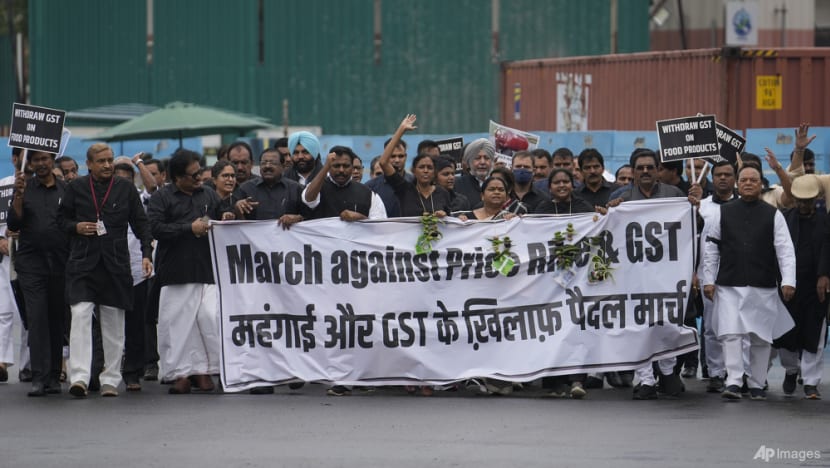India to present 2024 budget amid concerns over inflation, joblessness and low wages
CNA looks at how the Indian government’s first fiscal budget since the general election could help the country’s middle class and business community.

Lawmakers from India's opposition Congress party march during a protest against inflation, unemployment and other issues, outside the parliament in New Delhi, India, Friday, Aug. 5, 2022. (AP Photo/Altaf Qadri)

This audio is generated by an AI tool.
MUMBAI / NEW DELHI: For several years, Mumbai resident Sidheswar Shirsath has been trying to no avail to buy a house for his family.
While Sidheswar needs 15 million rupees (US$180,000) to purchase a three-bedroom home, the car rental business owner only earns about 60,000 to 70,000 rupees a month.
“We have rent to pay, school fees, household expenses and other necessities. If you consider all this in a city like Mumbai, it's very difficult to save money,” he told CNA.
Rising inflation and stagnant incomes have made it impossible for many middle-class Indians Sidheswar - who make up a majority of the world’s most populous country - to save enough money.
Sidheswar and many others hope that the government’s upcoming federal budget for the current financial year will have measures to help them.
The budget, set to be tabled on Tuesday (Jul 23), will be the first fiscal spending plan of Indian Prime Minister Narendra Modi’s third term in office. It is expected to signal his government’s economic priorities for the next five years.
Modi has promised to focus on increasing savings for the middle class, with post-election surveys showing that inflation, unemployment and low incomes are among people’s main concerns.
The business community is also expecting more government spending and tax cuts to increase competitiveness.
TAX RELIEF ON THE CARDS?
Economists have predicted that the budget could deliver some income tax relief and an increase in the tax exemption limits for home loan repayments.
This could involve lowering some tax brackets, which stand at a 30 per cent tax rate for earnings of more than 1.5 million rupees.
Apart from boosting savings for the middle class, Modi has also pledged to improve their quality of life.
Members of the public whom CNA spoke to cited concerns about rising costs of living, inflation and youth unemployment.
“Diesel and petrol have become so expensive. How can the common man afford this?” one questioned.
“Two things have become a big issue. One is obviously youth employment. The other is rising disparity, including disparity between the upper income and middle income groups, and also (between) rural and urban (groups),” said Sujan Hajra, chief economist and executive director at Anand Rathi Shares and Stock Brokers.
The budget could partly address these concerns, he added.
Any tax relief for the population can provide a much-needed boost to consumer spending as well, economists noted.
While the country’s gross domestic product growth came in at more than 8 per cent in the last financial year, consumption only grew at half that pace.
BUSINESSES ALSO SEEK TAX REDUCTION
Meanwhile, some businesses have expressed worries that Tuesday’s budget will offer more relief only for big businesses.
This comes as smaller businesses, often called the backbone of the Indian economy, are struggling due to high inflation, reducing customers’ spending capacity.
Some have called for a reduction in goods and services taxes (GST).
India’s finance ministry said earlier this month that GST brought significant relief to households when it was implemented seven years ago. It replaced local taxes that were higher and made essential items such as household appliances and mobile phones cheaper.
However, smaller businesses believe that GST, which stands at between 18 and 28 per cent on most items, threatens to dampen sales. It is a cost that companies usually pass on to consumers.
They said a further reduction could help make them more competitive, especially as the festive season approaches and demand is set to heat up.
India’s festive season typically runs for several weeks until the Hindu religious festival of Diwali, which takes place on Nov 1 this year.
“The customers tell us 28 per cent GST on some of these products is too high. I think this should be lower,” said Sushil Thakur, manager of Arvee Sales, an electronics store in New Delhi.
“If the taxes are reduced, then people’s purchasing capacity will increase. When that happens, sales will also grow,” he added.
ALLEVIATE RURAL DISTRESS
Some analysts believe the government could move away from fiscal consolidation and focus on adding to people’s disposable incomes.
To do that, experts have recommended alleviating rural distress through measures such as direct cash transfers to farmers and agricultural subsidies.
Industry bodies also expect measures to help manufacturers, and believe the government could announce performance-linked incentives to boost output. However, they argued more capital expenditure, or capex, on infrastructure is needed.
“The government should also look into increasing the capex. Once the government increases capex, we have seen that the private sector also follows that,” said Ajay Sahai, director-general and CEO of the Federation of Indian Export Organisations.
“So a lot of companies, both Indian and global companies who are looking to invest in the country, can take advantage of that.”
Attracting international firms to manufacture in India has been one of Modi’s key goals in his past two terms.
In light of that, industry bodies expect this year’s spending plan to offer tax breaks to new foreign manufacturers and some tax exemptions to foreign service providers, in hopes of adding jobs.
JOB CREATION SHOULD BE TOP PRIORITY
Job creation must be a top priority, with a focus on generating high-paying quality employment, said experts.
At the beginning of his third term, Modi said his main objective was to set India on a path to becoming a developed country by 2047.
While analysts differed on how likely this can be achieved, they agreed that the upcoming budget needs to focus on jobs, farmers' incomes, and boosting manufacturing to have a shot at realising that goal.
Government data showed that India generated more than 46 million new jobs in the previous fiscal year. However, opposition parties claimed these jobs were young people taking up farming due to a lack of high-paying roles in cities.
Government officials have brushed aside these comments, along with concerns by the private sector that India is not generating nearly enough employment.
Anand Rathi Shares and Stock Brokers' Hajra noted that about 40 per cent of the country’s workforce is employed in agriculture and allied activities with “abysmally low productivity”.
“You need occupational transformation … whereby people leave these low productivity jobs to high productivity jobs, both in manufacturing and services areas,” he added.


















